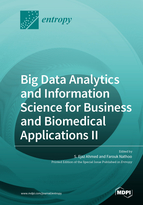Big Data Analytics and Information Science for Business and Biomedical Applications II
A special issue of Entropy (ISSN 1099-4300). This special issue belongs to the section "Signal and Data Analysis".
Deadline for manuscript submissions: closed (15 December 2021) | Viewed by 18673
Special Issue Editors
Interests: model selection; post-estimation and prediction; shrinkage and empirical Bayes; Bayesian data analysis; machine learning; business; information science; statistical genetics; image analysis
Special Issues, Collections and Topics in MDPI journals
Interests: Bayesian methods; statistical computing; spatial statistics; high-dimensional data; statistical modeling; neuroimaging statistics
Special Issues, Collections and Topics in MDPI journals
Special Issue Information
Dear Colleagues,
In today’s data-centric world, there is a host of buzzwords appearing everywhere in digital and print media. We encounter data in every walk of life, and the information it contains can be used to improve society, business, health, and medicine. This presents a substantial opportunity for analytically and objectively minded researchers. Making sense of data and extracting meaningful information from it may not be an easy task. The rapid growth in the size and scope of datasets in a host of disciplines has created the need for innovative statistical strategies for analyzing and visualizing such data.
An enormous trove of digital data has been produced by biomedicine researchers worldwide, including genetic variants genotyped or sequenced at genome-wide scales, gene expression measured under different experimental conditions, biomedical imaging data including neuroimaging data, electronic medical records (EMR) of patients, and many more.
The rise of ‘Big Data’ will not only deepen our understanding of complex human traits and diseases, but will also shed light on disease prevention, diagnosis, and treatment. Undoubtedly, comprehensive analysis of Big Data in genomics and neuroimaging calls for statistically rigorous methods. Various statistical methods have been developed to accommodate the features of genomic studies as well as studies examining the function and structure of the brain. Meanwhile, statistical theories have also correspondingly been developed.
Alongside biomedical applications, there has been a tremendous increase and interest in the use of Big Data towards business and financial applications. Financial time series analysis and prediction problems present many challenges for the development of statistical methodology and computational strategies for streaming data.
The analysis of Big Data in biomedical as well as business and financial research has drawn much attention from researchers worldwide. This Special Issue aims to provide a platform for the deep discussion of novel statistical methods developed for the analysis of Big Data in these areas. Both applied and theoretical contributions to these areas will be showcased.
The contributions to this Special Issue will present new and original research in statistical methods and applications in biomedical and business research. Contributions can have either an applied or theoretical perspective and emphasize different statistical problems with special emphasis on data analytics and statistical methodology. Manuscripts summarizing the most recent state-of-the-art on these topics are welcome.
Prof. Dr. S. Ejaz Ahmed
Dr. Farouk Nathoo
Guest Editors
Manuscript Submission Information
Manuscripts should be submitted online at www.mdpi.com by registering and logging in to this website. Once you are registered, click here to go to the submission form. Manuscripts can be submitted until the deadline. All submissions that pass pre-check are peer-reviewed. Accepted papers will be published continuously in the journal (as soon as accepted) and will be listed together on the special issue website. Research articles, review articles as well as short communications are invited. For planned papers, a title and short abstract (about 100 words) can be sent to the Editorial Office for announcement on this website.
Submitted manuscripts should not have been published previously, nor be under consideration for publication elsewhere (except conference proceedings papers). All manuscripts are thoroughly refereed through a single-blind peer-review process. A guide for authors and other relevant information for submission of manuscripts is available on the Instructions for Authors page. Entropy is an international peer-reviewed open access monthly journal published by MDPI.
Please visit the Instructions for Authors page before submitting a manuscript. The Article Processing Charge (APC) for publication in this open access journal is 2600 CHF (Swiss Francs). Submitted papers should be well formatted and use good English. Authors may use MDPI's English editing service prior to publication or during author revisions.








